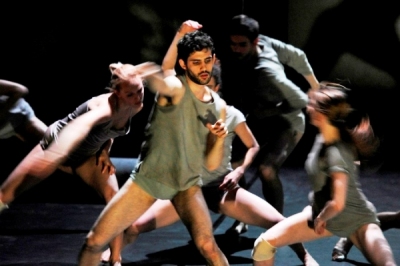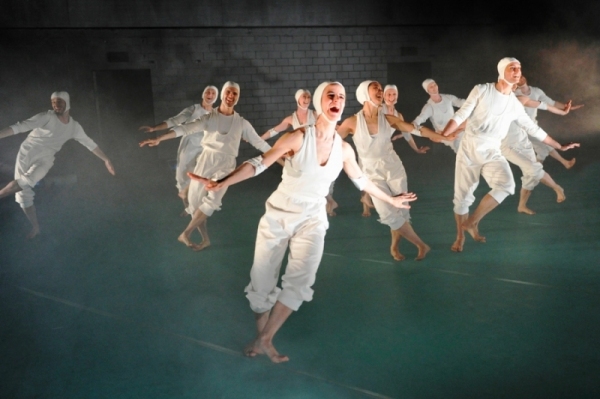Bern:Ballett, Linbury Studio, Royal Opera House | reviews, news & interviews
Bern:Ballett, Linbury Studio, Royal Opera House
Bern:Ballett, Linbury Studio, Royal Opera House
Form and content slug it out: nobody's a winner, though
Being a choreographer is harder than it looks. Steps, movement, are just the beginning. On top of that you need to have a sense of theatricality, and then, even more, you need to be able to convey your ideas, through movement alone, to the audience. On these counts, Bern:Ballett’s visit to the Linbury fails to make the grade.
Cathy Marston, Royal Ballet-trained, was the Opera House's first associate choreographer in residence a decade ago, and her works have had frequent showings over the years now. She is a serious and dedicated worker, she clearly has big ideas she wants to explore, but unfortunately her ability to communicate those ideas is not increasing.
 Clara (main picture above, and below right) centres on the love life of Clara Schumann. A formidable pianist, trained by her overbearing father, she finally broke away to marry Schumann, whose mental instability meant that Clara had to continue touring to maintain their growing family; in turn, she was loved by Brahms, and the passions between the three, together with their own passion for the music world they are creating, are Marston’s themes.
Clara (main picture above, and below right) centres on the love life of Clara Schumann. A formidable pianist, trained by her overbearing father, she finally broke away to marry Schumann, whose mental instability meant that Clara had to continue touring to maintain their growing family; in turn, she was loved by Brahms, and the passions between the three, together with their own passion for the music world they are creating, are Marston’s themes.
The stage is attractively set with dropped rolls of photographer’s backing paper, which are gradually unfurled over the evening. The music, well played by Sonja Lohmiller, is a mix of Schumann and Brahms, and, most welcome, the splendid baritone Benoît Capt appears to sing lieder.
But what is going on in front is limited in vocabulary – all three leads, and the corps, have the same dense, clotted, turned-in steps, with arms held locked in at shoulder height, arms curved in like mittened piano players. And the piece is limited in emotional affect – we can tell they are all upset, but at 50 minutes, that’s a lot of upset for very little return.
At one moment the corps lies down, like piano keys, as Schumann gestures towards “playing” them, an embarrassingly reductive idea; at another, they roll and unroll across the floor behind the protagonists, like the ghost of their bad dreams continuing to haunt them during the day, a much better idea. But in this long piece, a few good ideas are spread far, far too thin.
Howl (pictured above), choreographed by American Andrea Miller, is more theatrically poised, better lit and with more of a sense of theatrical presentation. But what, apart from “the world is a nasty place”, the piece was supposed to represent, never becomes apparent. Miller produces some interesting moments: a man miming singing, as a girl’s childish voice is heard, using a fallen comrade’s foot as his mic, is disturbing rather than comic. Miller handles her group scenes well, too – but like Marston, she desperately wants to tell us something, it’s just not clear what.
- Bern:Ballett at the Linbury until tomorrow, 27 May
 Find Clara and Robert Schumann's recordings on Amazon
Find Clara and Robert Schumann's recordings on Amazon
Share this article
more Dance
 All You Need Is Death review - a future folk horror classic
Irish folkies seek a cursed ancient song in Paul Duane's impressive fiction debut
All You Need Is Death review - a future folk horror classic
Irish folkies seek a cursed ancient song in Paul Duane's impressive fiction debut
 MacMillan Celebrated, Royal Ballet review - out of mothballs, three vintage works to marvel at
Less-known pieces spanning the career of a great choreographer underline his greatness
MacMillan Celebrated, Royal Ballet review - out of mothballs, three vintage works to marvel at
Less-known pieces spanning the career of a great choreographer underline his greatness
 Carmen, English National Ballet review - lots of energy, even violence, but nothing new to say
Johan Inger's take on Carmen tries but fails to make a point about male violence
Carmen, English National Ballet review - lots of energy, even violence, but nothing new to say
Johan Inger's take on Carmen tries but fails to make a point about male violence
 WAKE, National Stadium, Dublin review - a rainbow river of dance, song, and so much else
THISISPOPBABY serves up a joyous tapestry of Ireland contemporary and traditional
WAKE, National Stadium, Dublin review - a rainbow river of dance, song, and so much else
THISISPOPBABY serves up a joyous tapestry of Ireland contemporary and traditional
 Swan Lake, Royal Ballet review - grand, eloquent, superb
Liam Scarlett's fine refashioning returns for a third season, and looks better than ever
Swan Lake, Royal Ballet review - grand, eloquent, superb
Liam Scarlett's fine refashioning returns for a third season, and looks better than ever
 First Person: Ten Years On - Flamenco guitarist Paco Peña pays tribute to his friend, the late, great Paco de Lucía
On the 10th anniversary of his death, memories of the prodigious musician who broadened the reach of flamenco into jazz and beyond
First Person: Ten Years On - Flamenco guitarist Paco Peña pays tribute to his friend, the late, great Paco de Lucía
On the 10th anniversary of his death, memories of the prodigious musician who broadened the reach of flamenco into jazz and beyond
 Dance for Ukraine Gala, London Palladium review - a second rich helping of international dancers
Ivan Putrov's latest gala was a satisfying mix of stars and young hopefuls
Dance for Ukraine Gala, London Palladium review - a second rich helping of international dancers
Ivan Putrov's latest gala was a satisfying mix of stars and young hopefuls
 Nelken: A Piece by Pina Bausch, Sadler's Wells review - welcome return for an indelible classic
A new generation of gifted performers for us to get to know
Nelken: A Piece by Pina Bausch, Sadler's Wells review - welcome return for an indelible classic
A new generation of gifted performers for us to get to know
 Dark With Excessive Bright, Royal Ballet review - a close encounter with dancers stripped bare
The Royal's Festival of New Choreography launches with an unforgettable walk in the dark
Dark With Excessive Bright, Royal Ballet review - a close encounter with dancers stripped bare
The Royal's Festival of New Choreography launches with an unforgettable walk in the dark
 La Strada, Sadler's Wells review - a long and bumpy road
Even the exceptional talents of Alina Cojocaru can't save dance adaptation of Fellini film
La Strada, Sadler's Wells review - a long and bumpy road
Even the exceptional talents of Alina Cojocaru can't save dance adaptation of Fellini film
 First Person: pioneering juggler Sean Gandini reflects on how the spirit of Pina Bausch has infiltrated his work
As Tanztheater Wuppertal Pina Bausch's 'Nelken' comes to Sadler’s Wells, a tribute from across the art forms
First Person: pioneering juggler Sean Gandini reflects on how the spirit of Pina Bausch has infiltrated his work
As Tanztheater Wuppertal Pina Bausch's 'Nelken' comes to Sadler’s Wells, a tribute from across the art forms
 Manon, Royal Ballet review - a glorious half-century revival of a modern classic
Fifty years on, Kenneth MacMillan's crash-and-burn anti-heroine is riding high
Manon, Royal Ballet review - a glorious half-century revival of a modern classic
Fifty years on, Kenneth MacMillan's crash-and-burn anti-heroine is riding high

Add comment